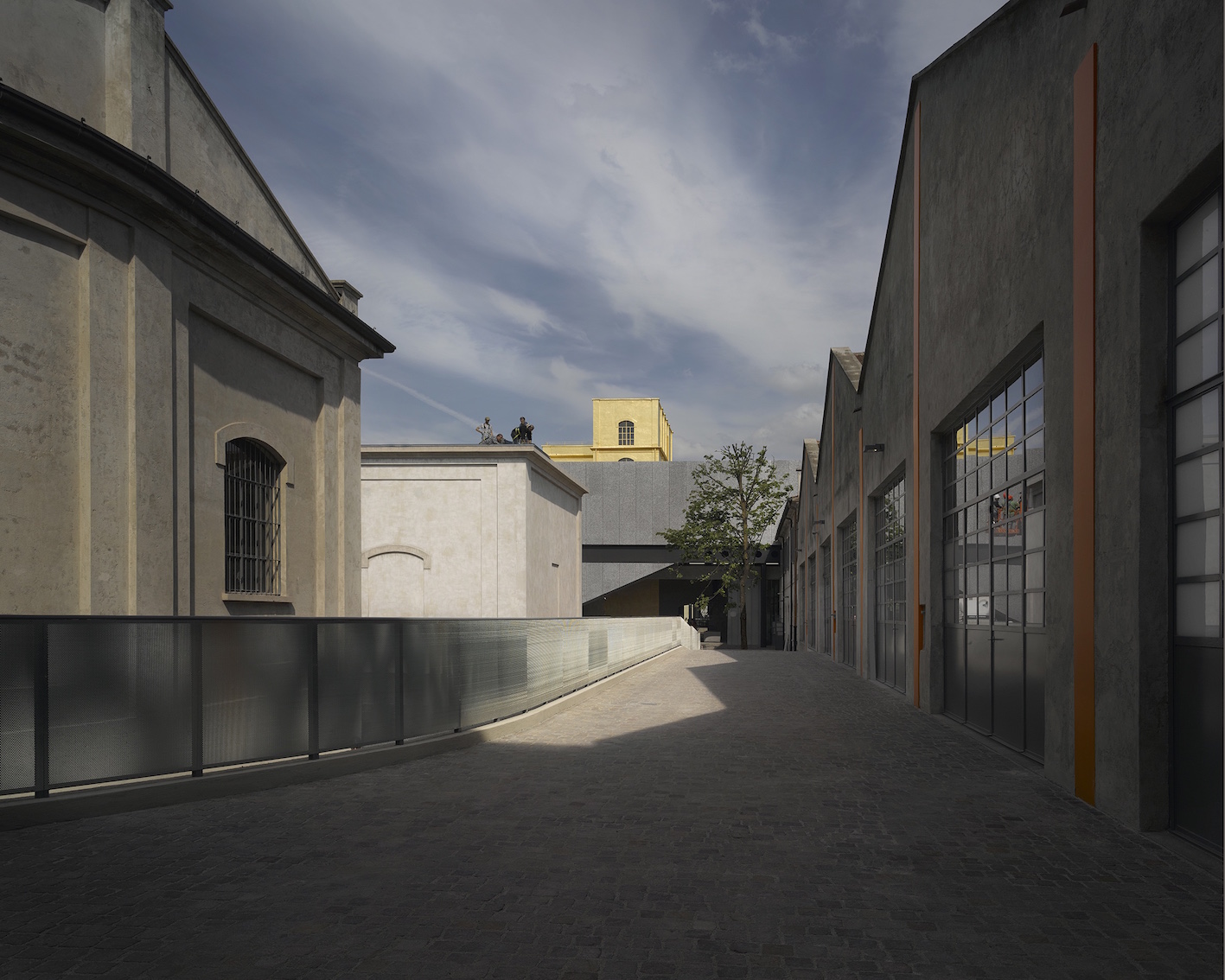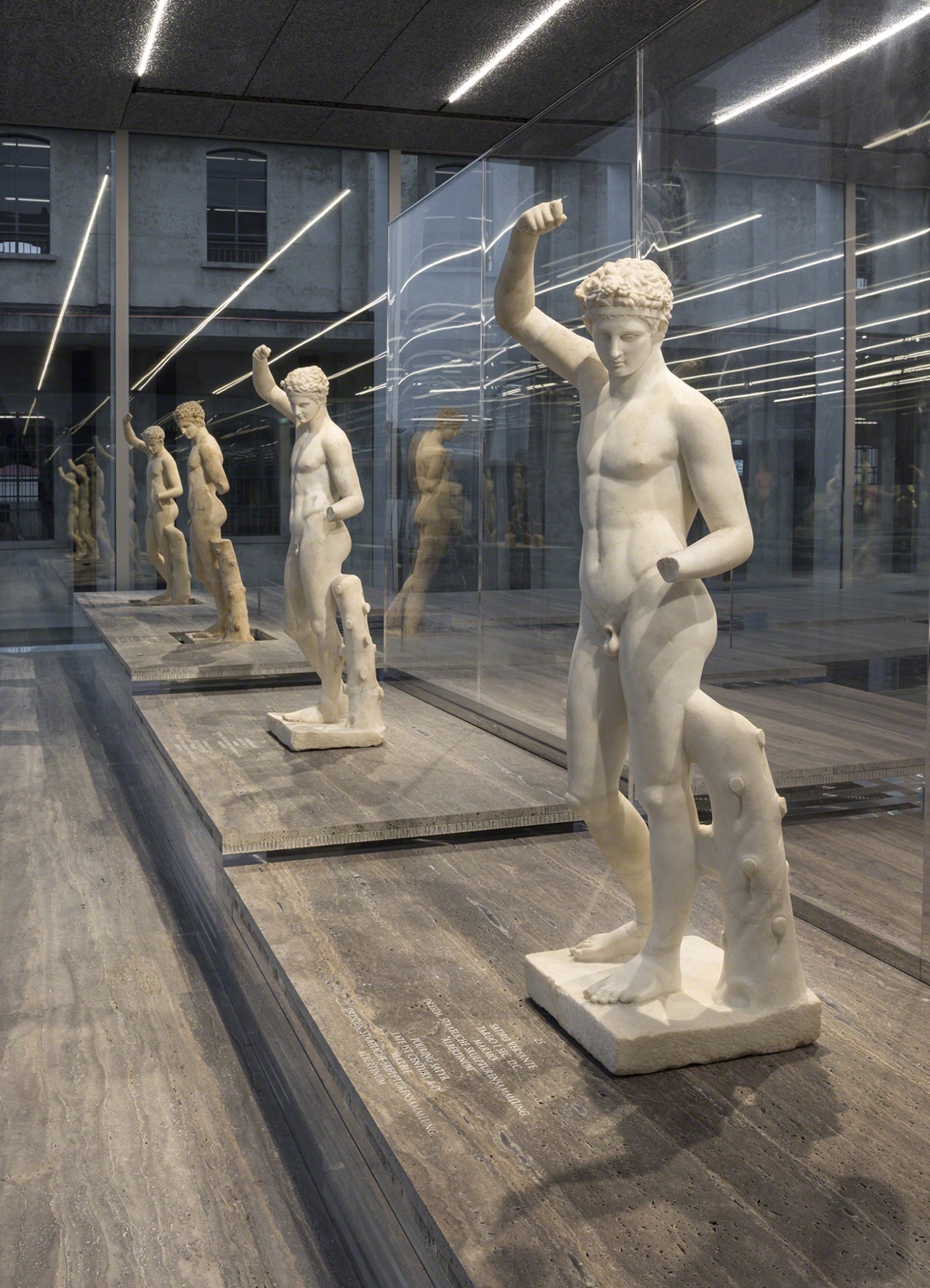15 May 2015
After seven years of work, the new complex of the Fondazione Prada, OMA’s much awaited project that sets the seal on the long collaboration of the Dutch firm headed by Rem Koolhaas with the fashion house, was opened to the public on May 9. Miuccia Prada and Patrizio Bertelli had been feeling cramped in the premises on Via Fogazzaro, a vital venue for events of fashion and contemporary art that had been in use since 1993. However, it was not so much a banal question of space as of the need to embark on an initiative capable of expanding the range of action of the foundation—which in addition to contemporary art will now turn its attention to the art of the past and to literature, the movies and music—and to create a new center of culture able to attract both insiders and the general public, while revitalizing an off-center area of Milan, beyond Piazzale Lodi. Arriving at Largo Isarco 2, you feel somewhat disorientated: the open space in front of the entrance of this former distillery constructed in 1910 is silent and empty and the small buildings that house the offices and library, next to the wrought-iron gate, are apparently unassuming, soberly renovated with full respect for the preexisting arrangement and interrupted only by the luminous sign with the foundation’s logo. But as soon as you enter this great campus of art, which combines three new structures with seven original buildings and covers a total area of 19 000 square meters, Rem Koolhaas’s design is revealed in all its intelligence.

New Milan venue of Fondazione Prada, 2015. Photo: Bas Princen.
Walking down the entrance way you come at once, on the left, to the Podium, one of the three new units designed by OMA, characterized by the juxtaposition of a structure built of aluminum foam—generally used for military purposes—with large glazed bays on three sides. The space houses the inaugural exhibition Serial Classic, curated by Salvatore Settis and Anna Anguissola and laid out on both levels of the building. The play of contrasts and the research into materials continues with a four-story construction clad in gold leaf, right next to the Podium: the choice of a precious facing for the Haunted House—as the architect dubbed it because of the state of neglect in which he found it—was dictated by the desire to give a visual signal of the wealth to be found even in such an out-of-the-way part of the city—characterized by abandoned factories and social housing. In addition, this covering of medieval origin costs less than a facing like marble, as Koolhaas pointed out at the press conference. The Haunted House contains a permanent installation by Robert Gober and two works by Louise Bourgeois, perfectly integrated into the spaces. Looking out from the windows that face north you can see the library and the Bar Luce, designed by the movie director Wes Anderson with the aim of re-creating the atmosphere of a Milanese café of the fifties and sixties. It’s décor makes explicit references to two films set in the Lombard capital: Vittorio De Sica’s Miracolo a Milano (1951) and Luchino Visconti’s Rocco e i suoi fratelli (1960). There is even a pinball machine. The journey through culture continues behind the Podium with the Cinema, the new building clad in mirrored steel panels that is opening its own program of exhibitions with a documentary by Roman Polanski (Roman Polanski. My Inspirations). And there is art here too: the foyer houses a ceramic work by Lucio Fontana, La battaglia (The Battle, created for the Cinema Arlecchino in Milan), while in the cellar we find Thomas Demand’s permanent installation Processo Grottesco (2006-07). Finally, you arrive at the large cisterns and the storehouses, a perfect setting in which to display part of Prada’s substantial art collection: an area barely touched by Koolhaas’s architectural intervention, hardly more than cleaned up and reorganized in a simple but painstaking operation of set design: just one work for each of the three cisterns that house the Triptych (which will present three works from the collection in rotation), thematic exhibitions in the North Gallery (the first is In Part, curated by Nicholas Cullinan) and a selection of works from the Prada collection in the South Gallery and part of the storehouses (An Introduction, curated by Germano Celant with Miuccia Prada).

New Milan venue of Fondazione Prada, 2015. Photo: Bas Princen.
The typological variety, the contrast between settings and materials and the reasoned respect shown for the preexisting complex are the keys to the interpretation of a unique and fascinating, elaborate and unpredictable hub of the arts that eludes a schematic definition. “[It] is not a preservation project, and it’s not new architecture,” Rem Koolhaas has correctly pointed out, going on to speak of a process of permanent interaction between these fragments (and it is no coincidence that Fragments is the title of Delfino Sisto Legnani’s photographic project telling the story of the making of the new foundation), “that will not congeal into a single image”. To get the whole picture of the operation we must wait for the completion of the Tower, a place still semi-shrouded in mystery. All that is known is that it will have nine levels and an irregular concrete structure, that it will house a restaurant and that each floor will have a height one meter greater than the one below, so that the art can be appreciated in different ways in different spaces and at different heights. An additional, enigmatic fragment that enriches the puzzle of this splendid citadel of art.

Fragments. Photo: Delfino Sisto Legnani.

Fragments. Photo: Delfino Sisto Legnani.

Fragments. Photo: Germana Lavagna.

Fragments. Photo: Giulio Ghirardi.

Fragments. Photo: Giulio Ghirardi.

Fragments. Photo: Leo Iannelli.

An Introduction, Fondazione Prada, Milan, 2015. Photo: Attilio Maranzano.

Bar Luce. Fondazione Prada, Milan, 2015. Photo: Attilio Maranzano.

Robert Gober, Corner Door and Doorframe, 2014-2015. Photo: Attilio Maranzano.

Serial Classic, Fondazione Prada, Milan, 2015. Photo: Attilio Maranzano.

Serial Classic, Fondazione Prada, Milan, 2015. Photo: Attilio Maranzano.

Serial Classic, Fondazione Prada, Milan, 2015. Photo: Attilio Maranzano.